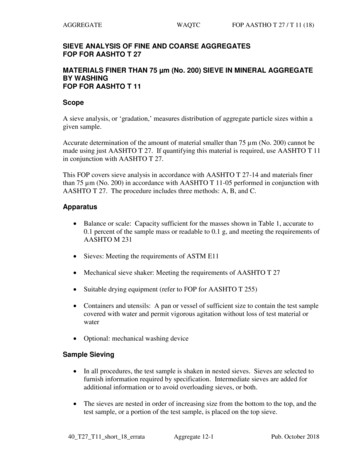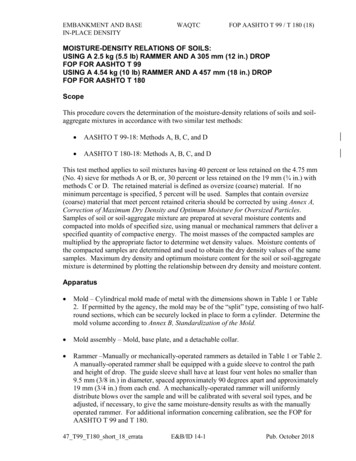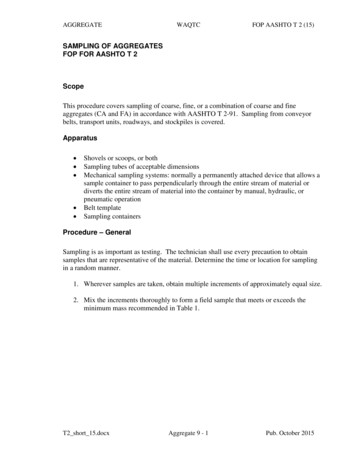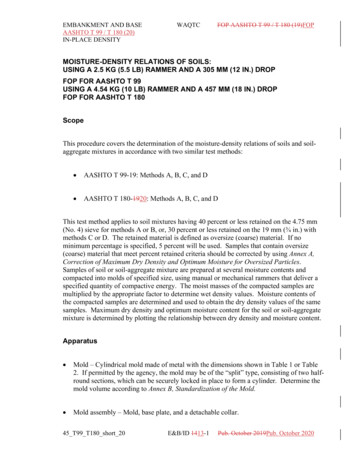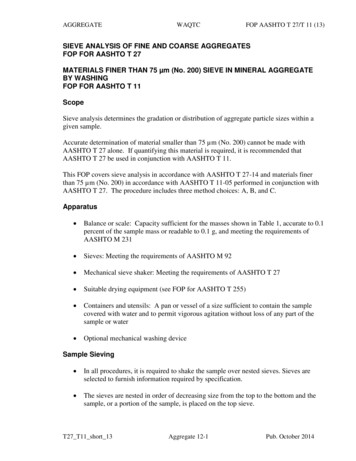
Transcription
AGGREGATEWAQTCFOP AASHTO T 27/T 11 (13)SIEVE ANALYSIS OF FINE AND COARSE AGGREGATESFOP FOR AASHTO T 27MATERIALS FINER THAN 75 µm (No. 200) SIEVE IN MINERAL AGGREGATEBY WASHINGFOP FOR AASHTO T 11ScopeSieve analysis determines the gradation or distribution of aggregate particle sizes within agiven sample.Accurate determination of material smaller than 75 µm (No. 200) cannot be made withAASHTO T 27 alone. If quantifying this material is required, it is recommended thatAASHTO T 27 be used in conjunction with AASHTO T 11.This FOP covers sieve analysis in accordance with AASHTO T 27-14 and materials finerthan 75 µm (No. 200) in accordance with AASHTO T 11-05 performed in conjunction withAASHTO T 27. The procedure includes three method choices: A, B, and C.Apparatus Balance or scale: Capacity sufficient for the masses shown in Table 1, accurate to 0.1percent of the sample mass or readable to 0.1 g, and meeting the requirements ofAASHTO M 231 Sieves: Meeting the requirements of AASHTO M 92 Mechanical sieve shaker: Meeting the requirements of AASHTO T 27 Suitable drying equipment (see FOP for AASHTO T 255) Containers and utensils: A pan or vessel of a size sufficient to contain the samplecovered with water and to permit vigorous agitation without loss of any part of thesample or water Optional mechanical washing deviceSample Sieving In all procedures, it is required to shake the sample over nested sieves. Sieves areselected to furnish information required by specification. The sieves are nested in order of decreasing size from the top to the bottom and thesample, or a portion of the sample, is placed on the top sieve.T27 T11 short 13Aggregate 12-1Pub. October 2014
AGGREGATE WAQTCFOP AASHTO T 27/T 11 (13)Sieves are shaken in a mechanical shaker for approximately 10 minutes, or theminimum time determined to provide complete separation for the sieve shaker beingused. As established by the Time Evaluation.Time EvaluationThe sieving time for each mechanical sieve shaker shall be checked at least annually todetermine the time required for complete separation of the sample by the following method:1. Shake the sample over nested sieves for approximately 10 minutes.2. Provide a snug-fitting pan and cover for each sieve, and hold in a slightly inclinedposition in one hand.3. Hand-shake each sieve by striking the side of the sieve sharply and with an upwardmotion against the heel of the other hand at the rate of about 150 times per minute,turning the sieve about one sixth of a revolution at intervals of about 25 strokes.If more than 0.5 percent by mass of the total sample prior to sieving passes any sieve afterone minute of continuous hand sieving adjust shaker time and re-check.In determining sieving time for sieve sizes larger than 4.75 mm (No. 4), limit the material onthe sieve to a single layer of particles.Overload Determination For sieves with openings smaller than 4.75 mm (No. 4), the mass retained on anysieve shall not exceed 7 kg/m2 (4 g/in2) of sieving surface. For sieves with openings 4.75 mm (No. 4) and larger, the mass, in grams shall notexceed the product of 2.5 (sieve opening in mm) (effective sieving area). SeeTable 1.Additional sieves may be necessary to keep from overloading sieves or to provide otherinformation, such as fineness modulus. The sample may also be sieved in increments toprevent overload.T27 T11 short 13Aggregate 12-2Pub. October 2014
AGGREGATEWAQTCFOP AASHTO T 27/T 11 (13)TABLE 1Maximum Allowable Mass of Material Retained on a Sieve, gNominal Sieve Size, mm (in.)Exact size is smaller (see AASHTO T 27)Sieve Sizemm (in.)9075635037.525.019.016.012.59.56.34.75-4.75(3 1/2)(3)(2 1/2)(2)(1 1/2)(1)(3/4)(5/8)(1/2)(3/8)(1/4)(No. 4)(-No. 4)203 dia(8)305 6001100800470305 by 305 350 by 350(12 12)(14 14)Sieving Area 3800220029001500190011001500650860372 by 580(16 0860067005100340026001510Sample PreparationObtain samples in accordance with the FOP for AASHTO T 2 and reduce to the size shownin Table 2 in accordance with the FOP for AASHTO T 248. These sample sizes are standardfor aggregate testing but, due to equipment restraints, samples may need to be partitionedinto several “subsamples.” For example, a gradation that requires 100 kg (220 lbs) ofmaterial would not fit into a large tray shaker in one batch.Some agencies permit reduced sample sizes if it is proven that doing so is not detrimental tothe test results. Some agencies require larger sample sizes. Check agency guidelines forrequired or permitted test sample sizes.T27 T11 short 13Aggregate 12-3Pub. October 2014
AGGREGATEWAQTCFOP AASHTO T 27/T 11 (13)TABLE 2Sample Sizes for Aggregate Gradation TestNominal MaximumSize* mm (in.)4.75 (No. 4)6.3 (1/4)9.5 (3/8)12.5 (1/2)19.0 (3/4)25.0 (1)37.5 (1 1/2)50 (2)63 (2 1/2)75 (3)90 (3 1/2)100 (4)125 (5)Minimum Dry Massg (lb)500 (1)1000 (2)1000 (2)2000 (4)5000 (11)10,000 (22)15,000 (33)20,000 (44)35,000 (77)60,000 (130)100,000 (220)150,000 (330)300,000 (660)*Nominal maximum size: One sieve larger than the first sieve to retain more than 10 percent of thematerial using an agency specified set of sieves based on cumulative percent retained. Where largegaps between specification sieves exist, intermediate sieve(s) may be inserted to determine nominalmaximum size.Selection of ProcedureAgencies may specify what method will be performed. If a method is not specified methodA will be performed.OverviewMethod A Determine dry mass of original sample Wash through a 75µm (No. 200) sieve Determine dry mass of washed sample Sieve materialMethod B Determine dry mass of original sample Wash through a 75µm (No. 200) sieve Determine dry mass of washed sample Sieve coarse material Determine dry mass of fine material Reduce fine portion Determine mass of reduced portion Sieve fine portionT27 T11 short 13Aggregate 12-4Pub. October 2014
AGGREGATEWAQTCFOP AASHTO T 27/T 11 (13)Method C Determine dry mass of original sample Sieve coarse material Determine mass of fine material Reduce fine portion Determine mass of reduced portion Wash through a 75µm (No. 200) sieve Determine dry mass of washed sample Sieve reduced fine portionProcedure Method A1. Dry the sample to a constant mass in accordance with the FOP for AASHTO T 255,and record to the nearest 0.1 percent of the total sample mass or 0.1 g.2. When the specification requires that the amount of material finer than 75 µm (No.200) be determined, perform Step 3 through Step 9; otherwise, skip to Step 10.3. Nest a sieve, such as a 2.0 mm (No. 10), above the 75 µm (No. 200) sieve.4. Place the test sample in a container and add sufficient water to cover it.Note 1: A detergent, dispersing agent, or other wetting solution may be added to the water to assure athorough separation of the material finer than the 75 µm (No. 200) sieve from the coarser particles.There should be enough wetting agent to produce a small amount of suds when the sample is agitated.Excessive suds may overflow the sieves and carry material away with them.5. Agitate vigorously to ensure complete separation of the material finer than 75 µm(No. 200) from coarser particles and bring the fine material into suspension above thecoarser material. When using a mechanical washing device, exercise caution to avoiddegradation of the sample.6. Immediately pour the wash water containing the suspended and dissolved solids overthe nested sieves, being careful not to pour out the coarser particles.7. Add a second change of water to the sample remaining in the container, agitate, andrepeat Step 6. Repeat the operation until the wash water is reasonably clear. If adetergent or dispersing agent is used, continue washing until the agent is removed.8. Remove the upper sieve, return material retained to the washed sample.9. Rinse the material retained on the 75 µm (No.200) sieve until water passing throughthe sieve is reasonably clear.10. Return all material retained on the 75 µm (No.200) sieve to the container by flushinginto the washed sample.T27 T11 short 13Aggregate 12-5Pub. October 2014
AGGREGATEWAQTCFOP AASHTO T 27/T 11 (13)Note 2: Excess water may be carefully removed with a bulb syringe as long as the removed water isdischarged back over the No. 200 sieve to preclude loss of fines.11. Dry the washed aggregate to constant mass in accordance with the FOP for AASHTOT 255, and then cool prior to sieving. Record the “dry mass after washing”.12. Select sieves to furnish the information required by the specifications. Nest the sievesin order of decreasing size from top to bottom and place the sample, or a portion ofthe sample, on the top sieve.13. Place sieves in mechanical shaker and shake for the minimum time determined toprovide complete separation for the sieve shaker being used (approximately 10minutes).Note 3: Excessive shaking (more than 10 minutes) may result in degradation of the sample.14. Determine the individual or cumulative mass retained on each sieve and the pan to thenearest 0.1 percent or 0.1 g. Ensure that all material trapped in full openings of thesieve are cleaned out and included in the mass retained.Note 4: For sieves No. 4 and larger, material trapped in less than a full opening shall be checked bysieving over a full opening. Use coarse wire brushes to clean the 600 µm (No. 30) and larger sieves,and soft bristle brushes for smaller sieves.15. In the case of coarse / fine aggregate mixtures, the minus 4.75 mm (No. 4) may bedistributed among two or more sets of sieves to prevent overloading of individualsieves.CalculationsThe total mass of the material after sieving, for both coarse and fine portions should checkclosely with the original mass of sample placed on the sieves. If performing T 11 with T 27,this would be the dry mass after wash. If performing just T 27 this would be the original drymass. When the masses before and after sieving differ by more than 0.3 percent, do not usethe results for acceptance purposes.Check SumTotal mass of material after sieving must agree with mass before sieving to within 0.3percent.𝑑𝑟𝑦 𝑚𝑎𝑠𝑠 𝑎𝑓𝑡𝑒𝑟 𝑤𝑎𝑠ℎ𝑖𝑛𝑔 𝑡𝑜𝑡𝑎𝑙 𝑚𝑎𝑠𝑠 𝑎𝑓𝑡𝑒𝑟 𝑠𝑖𝑒𝑣𝑖𝑛𝑔 100𝑑𝑟𝑦 𝑚𝑎𝑠𝑠 𝑎𝑓𝑡𝑒𝑟 𝑤𝑎𝑠ℎ𝑖𝑛𝑔Calculate the total percentages passing, individual or cumulative percentages retained, orpercentages in various size fractions to the nearest 0.1 percent by dividing the masses forT27 T11 short 13Aggregate 12-6Pub. October 2014
AGGREGATEWAQTCFOP AASHTO T 27/T 11 (13)Method A, or adjusted masses for methods B and C, on the individual sieve masses orcumulative sieve masses by the total mass of the initial dry sample. If the same test samplewas first tested by T 11, use the total dry sample mass prior to washing in T 11 as the basisfor calculating all percentages. Report percent passing as indicated in the “Report” section atthe end of this FOP.Percent Retained:Where:IPR Individual Percent RetainedCPR Cumulative Percent RetainedM Total Dry Sample mass before washingIMR Individual Mass Retained OR Adjusted Individual mass from Methods B or CCMR Cumulative Mass Retained OR Adjusted Cumulative Mass fromMethods B or C𝐼𝑃𝑅𝐼𝑀𝑅 100𝑀𝑜𝑟𝐶𝑃𝑅 𝐶𝑀𝑅 100𝑀Percent Passing (Calculated):Where:PP Percent PassingPPP Previous Percent Passing𝑃𝑃 𝑃𝑃𝑃 𝐼𝑃𝑅Method A Sample Calculation𝑜𝑟𝑃𝑃 100 𝐶𝑃𝑅Calculate percent retained on and passing each sieve on the basis of the total mass of theinitial dry sample. This will include any material finer than 75 µm (No. 200) that waswashed out.Example:Dry mass of total sample, before washing: 5168.7 gDry mass of sample, after washing out the 75µm (No. 200) minus: 4911.3 gAmount of 75µm (No. 200) minus washed out: 5168.7 g – 4911.3 g 257.4 gT27 T11 short 13Aggregate 12-7Pub. October 2014
AGGREGATEWAQTCFOP AASHTO T 27/T 11 (13)Gradation on All SievesSieve Sizemm (in.)19.0 (3/4)12.5 (1/2)9.5(3/8)4.75 (No. 4)2.36 (No. 8)1.18 (No. 16)0.600 (No. 30)0.300 (No. 50)0.150 (No. 100)0.075(No. 1008674513423171285.5*Report 75 µm (No. 200) sieve to 0.1 percent. Report all others to 1 percent.Check sum:4911.3 𝑔 4905.9 𝑔 100 0.1%4911.3 𝑔This is less than 0.3 percent therefore the results can be used for acceptance purposes.Percent Retained:9.5 mm (3/8) sieve:619.2 𝑔 100 12.0%5168.7 𝑔𝑜𝑟1343.9 𝑔 100 26.0%5168.7 𝑔Percent Passing (Calculated):9.5 mm (3/8) sieve:86.0% 12.0% 74.0% 𝑜𝑟 100% – 26.0% 74.0%T27 T11 short 13Aggregate 12-8Pub. October 2014
AGGREGATEWAQTCFOP AASHTO T 27/T 11 (13)Procedure Method B1. Perform steps 1 through 11 from the “Procedure – Method A”, then continue asfollows:2. Select sieves to furnish information required by the specifications. Nest the sieves inorder of decreasing size from top to bottom through the 4.75 mm (No. 4) with a panat the bottom to retain the minus 4.75 mm (No. 4).3. Place the sample, or a portion of the sample, on the top sieve. Sieves may already bein the mechanical shaker, or place the sieves in the mechanical shaker and shake forthe minimum time determined to provide complete separation for the sieve shakerbeing used (approximately 10 minutes).Note 3: Excessive shaking (more than 10 minutes) may result in degradation of the sample.4. Determine the individual or cumulative mass retained on each sieve to the nearest 0.1percent or 0.1 g. Ensure that all particles trapped in full openings of the sieve arecleaned out and included in the mass retained.Note 4: For sieves No. 4 and larger, material tra
AASHTO T 27 be used in conjunction with AASHTO T 11. This FOP covers sieve analysis in accordance with AASHTO T 27-14 and materials finer than 75 µm (No. 200) in accordance with AASHTO T 11-05 performed in conjunction with AASHTO T 27. The procedure includes three method choices: A, B, and C. Apparatus Balance or scale: Capacity sufficient for the masses shown in Table 1, accurate to 0.1 .File Size: 201KBPage Count: 18
